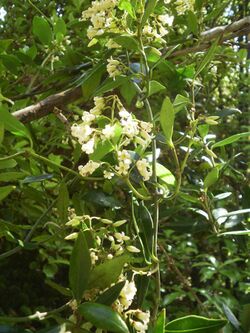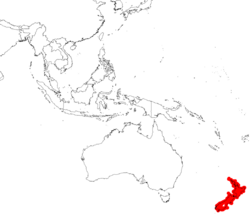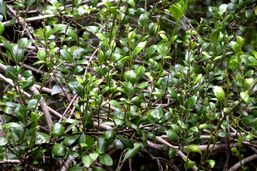Biology:Parsonsia heterophylla
| Parsonsia heterophylla | |
|---|---|

| |
| Scientific classification | |
| Kingdom: | Plantae |
| Clade: | Tracheophytes |
| Clade: | Angiosperms |
| Clade: | Eudicots |
| Clade: | Asterids |
| Order: | Gentianales |
| Family: | Apocynaceae |
| Genus: | Parsonsia |
| Species: | P. heterophylla
|
| Binomial name | |
| Parsonsia heterophylla A.Cunn.
| |

| |
| Occurrence data from GBIF | |
Parsonsia heterophylla, commonly called New Zealand Jasmine or Kaihua, is a climbing plant endemic to New Zealand.[1]
The name heterophylla comes from the differing leaf shapes that can be seen in seedlings and juvenile plants of the species.[2] Heterophylla means varied leaves, from the Greek words heteros and phullon.[3] Synonyms for this species include Parsonsia variabilis Lindl., Parsonsia albiflora Raoul and Parsonsia macrocarpa Colenso.[3] It can also be described as "The Varied-leaved Parsonsia".[4] There are 40 species of Parsonsia found in Asia, Australasia and the Pacific, P. heterophylla is one of two endemic Parsonsia species found in New Zealand.[5] It is more robust and has bigger flowers than its close relative, Parsonsia capsularis, which is also known as Akakiore or Small Māori Jasmine.[6]
Description
The flowers of P. heterophylla are "white, scented, and tubular with anthers hidden within the tube."[5] This species has also been observed rarely to have yellow flowers.[7] They appear in many-flowered, fairly compact clusters on the plant.[7] The flowers are small, each usually up to 8mm in size.[6] The flowers are often described for their peculiar scent.[1] Often seen draped over the tops of tall trees, the flowers are more recognisable by their scent than their appearance.[5]
The fruit of P. heterophylla is a long, narrow pod that opens to release tufted seeds.[5] These seeds pods are around 15 cm long.[6] Each pod holds numerous seeds, and each one is tipped with a tuft of silky hairs.[2] The two-valved pod opens from the tip downwards, bending outwards and raising seeds up so that their tufts can be caught by the wind.[8] The fruit pods start green, turning to brown and then after the seeds have been dispersed, the dry, empty pods hang a long time on the plant.[2]
The leaves of P. heterophylla are variable in size and shape, both in all stages of its life.[9] The leaves of seedlings and juvenile plants are largely diverse, and a range of small and round, long and narrow and irregularly shaped leaves can all be found mixed on the same plant.[7] In adults, the leaves are described as "opposite, rather shiny and rather dark green from above, much paler underneath, more or less smooth-edge but often somewhat wavy edged, more than 1 cm wide, often 2, 3, or 4 cm wide and up to 10cm long".[7] While the leaves of adult plants are usually shorter and broader than in juveniles, they are still variable in shape.[9] The leaf types can narrowly be defined as small round, long narrow and moderately broad and oblong.[10]
The twining stems of P. heterophylla are often tightly wrapped around host stems and are described as softly woody and flexible.[7] In older plants, the stem is woody towards the base.[9] Each stem is as thick as a quill and shining.[4] This branching climber can reach up to 10 metres tall by climbing up any plant within reach.[9]
Distribution
P. heterophylla is an indigenous or endemic species of New Zealand, meaning that it is not found anywhere else in the world.[11]
Its presence has been recorded in the North Island, South Island, Three Kings Islands and Stewart Island.[9] It is commonly found across the country in lowland or low montane forest.[5] Its preferred habitat is forest margins and clearings in coastal scrub patches.[6] It has been observed to grow side by side with its close relative Parsonsia capsularis in the Banks Peninsula, where hybrids are sometimes encountered.[7]
Life cycle
There is little information available on the timeline and life cycle of this species. This plant flowers from September to March, followed by seed pods from February.[1] Seeds are dispersed then by the wind.[8]
If one wants to plant P. heterophylla in their garden, the optimal time to collect seeds is between February and April.[12]
Interactions
P. heterophylla twine their young stems around other plants in order and grow and climb towards the sunlight.[6]
P. heterophylla is a host plant to a number of invertebrate species, including beetles, wasps, moths, butterflies, grasshoppers and sucking bugs.[13] The larvae of the moth Stigmella kaimanua feed on the leaves of P. heterophylla.[14] It also attracts the rare New Zealand Ribbonwood Aphid or Paradoxaphis plagianthi.[15] The sweet-scented flowers of P. heterophylla are attractive to night-flying moths.[9]
The nectar of P. heterophylla is eaten by the New Zealand Bellbird or Korimako.[16]
Further information
P. heterophylla's current conservation status is not threatened, according to the Department of Conservation.[3]
The flowers of P. heterophylla were historically often bound by Māori to the perches of bird-traps as a lure.[17]
References
- ↑ 1.0 1.1 1.2 Salmon, John T. (1991). Native New Zealand flowering plants. Auckland [N.Z.]: Reed. ISBN 0-7900-0684-7. OCLC 26036266. https://www.worldcat.org/oclc/26036266.
- ↑ 2.0 2.1 2.2 Moore, Lucy B. (1978). The Oxford book of New Zealand plants. J. B. Irwin. Wellington [N.Z.]: Oxford University Press. ISBN 0-19-558035-4. OCLC 3844208. https://www.worldcat.org/oclc/3844208.
- ↑ 3.0 3.1 3.2 "Parsonsia heterophylla" (in en). https://www.nzpcn.org.nz/flora/species/parsonsia-heterophylla/.
- ↑ 4.0 4.1 Laing, Robert Malcolm; Blackwell, Ellen W. (1949). Plants of New Zealand. Christchurch New Zealand: Whitcombe and Tombs. pp. 360.
- ↑ 5.0 5.1 5.2 5.3 5.4 Smith-Dodsworth, John C. (1991). New Zealand native shrubs and climbers. Auckland, N.Z.: David Bateman. ISBN 1-86953-069-1. OCLC 27264960. https://www.worldcat.org/oclc/27264960.
- ↑ 6.0 6.1 6.2 6.3 6.4 Salmon, John T. (1986). New Zealand flowers and plants in colour. Mural Books. ISBN 0-9597795-0-7. OCLC 33217447. http://worldcat.org/oclc/33217447.
- ↑ 7.0 7.1 7.2 7.3 7.4 7.5 Wilson, Hugh D. (2013). Plant life on Banks Peninsula. Cromwell, New Zealand. ISBN 978-0-9583299-6-5. OCLC 861302803. https://www.worldcat.org/oclc/861302803.
- ↑ 8.0 8.1 Martin, William (1961). The flora of New Zealand. Whitcombe and Tombs. OCLC 1191018. http://worldcat.org/oclc/1191018.
- ↑ 9.0 9.1 9.2 9.3 9.4 9.5 Eagle, Audrey Lily (1978). Eagle's 100 shrubs & climbers of New Zealand : companion volume to Eagle's 100 trees of New Zealand : botanical paintings & notes. Audrey Lily Eagle. Auckland: Collins. ISBN 0-00-216932-0. OCLC 5727559. https://www.worldcat.org/oclc/5727559.
- ↑ Cockayne, Leonard (1919). New Zealand plants and their story. By L. Cockayne .... Wellington, N.Z.: M.F. Marks, Govt. Printer. doi:10.5962/bhl.title.12016. http://dx.doi.org/10.5962/bhl.title.12016.
- ↑ "Flora of New Zealand | Taxon Profile | Parsonsia heterophylla". http://nzflora.info/factsheet/Taxon/Parsonsia-heterophylla.html.
- ↑ "Calendar for seed collecting - grasses, sedges, lilies, flaxes, epiphytes and climbers" (in en-nz). https://www.doc.govt.nz/get-involved/run-a-project/restoration-advice/native-plant-restoration/ecosource-seeds/collection-and-propagation-guide-grasses/calendar-for-seed-collecting-grasses/.
- ↑ "PlantSynz - Invertebrate herbivore biodiversity assessment tool: Database". https://plant-synz.landcareresearch.co.nz/ReportForm.aspx?RecordId=126&Type=P&SortBy=Alpha&Biostatus=a,c,e,n.
- ↑ "Stigmella kaimanua Donner & Wilkinson, 1989". Naturalis Biodiversity Center. http://nepticuloidea.info/category/nepticuloidea/stigmella/stigmella-new-zealand-species/stigmella-kaimanua.
- ↑ Kean, John; Stufkens, Marlon (January 2005). "Phenology, population ecology, and rarity of the New Zealand ribbonwood aphid,Paradoxaphis plagianthi". New Zealand Journal of Zoology 32 (3): 143–153. doi:10.1080/03014223.2005.9518407. ISSN 0301-4223.
- ↑ "Food preferences of the bellbird (Anthornis melanura) in native forest remnants on the Port Hills, Banks Peninsula, New Zealand" (in en). https://www.researchgate.net/publication/281628513.
- ↑ "Māori Plant Use Database Plant Use Details of Parsonsia heterophylla". https://maoriplantuse.landcareresearch.co.nz/WebForms/PeoplePlantsDetails.aspx?firstcome=firstcome&PKey=FA81C29F-243A-4921-8F30-8EA34BC15FD9.
Wikidata ☰ Q7140064 entry
 |




